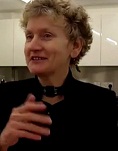 Railway turntable - turning the engine in a different direction
Railway turntable - turning the engine in a different direction I’ve often said that the first act turning point is a surprise that turns into the obstacle that drives the rest of the story (that’s the Smiley Thompson model). I also say (my model) that the first act turning point tells you what the film’s plot is ‘about’, as in ‘my film is ABOUT an actor who dresses up as a woman to get a job in a soap opera’ (Tootsie).
The first act turning point is that it’s exactly like the turntable on a railway line. It turns the engine of the film round and points it in a very specific direction – a direction which comes as a surprise, often an extreme surprise. For example, I’ve already mentioned Tootsie, so let’s look at how it works.
We sit down, we start to watch a film that’s all about a very good actor who’s so difficult to work with that he can’t get an acting job. He’s obviously going to have some kind of adventure, maybe to do with being an actor, maybe not. Then suddenly, this man is dressed up as woman and getting a job as female character in a soap opera! Hello? We have swiveled in a logical but utterly surprising direction. In Thelma and Louise two women go off on holiday, stop for a drink – and suddenly they’re murderers on the run. Again, the film has swung in a completely different although logical direction, a direction that gives us the film’s real story.
So, as I say, it’s like a railway turntable. Your railway turntable/first act turning point has to take your story on an interesting journey to somewhere even more interesting, or like the train, your film will come to a halt or go off the tracks completely. But unless you have that turnaround, that swiveling, that surprise it will be predictable. Of course, some films have a more striking first act turning point than others – and the lesser the surprise at the first act turning point the ‘quieter’ the film, the more ‘art house’.
Often when people say a script is more suitable for a telemovie it will be because it doesn’t have a surprising first act turning point. I’m not saying that such films are bad – they can be very very good indeed. It’s just an observation of what is causing the ‘quiet’ and ‘art house’ effect. As a writer you need to know what creates a ‘quiet’ ‘art house’ story and what creates something less subtle.
How to pick a good first act turning point To pick whether the first act turning point will work, here’s a trick. Check it against films that work well. Does it tick all the boxes that are ticked in those successful films (art house or otherwise)?
Here are the boxes that need to be ticked.
Box 1 The first act turning point is what the film is ‘about’ in terms of plot. Is that so with your film?
Box 2. The first act turning point is a physical surprise that turns into an obstacle that creates the whole story. Is that so with your film?
Box 3. The first act turning point is an entry into another world. Is that so with your film?
Box 4. The film’s climax answers the question raised by the first act turning point. Is that so with your film?
Let’s try the check list with the film Tootsie. The first act turning point is when Dustin Hoffman walks down the street disguised as a woman to get an acting job in a soap opera.
We can accurately say of Tootsie that it’s ‘about’ ‘what happens to a man who dresses up as a woman in order to get a job in a soap opera’. (Tick Box 1).
We can accurately say that the first act turning point is genuinely an unexpected surprise that turns into an obstacle that drives the rest of the film. (Tick box 2).
We can genuinely say that the first act turning point puts the protagonist into a new world – the world as experienced by a woman. (Tick Box 3)
Finally, the film’s climax genuinely answers the question raised by the first act turning point of: ‘how is a man who dresses up to get a job in a soap opera going to get out of that one!’ (Tick box 4).
Arguably, the first act turning point is the most vital structural element in the film. So much depends on it
 RSS Feed
RSS Feed


